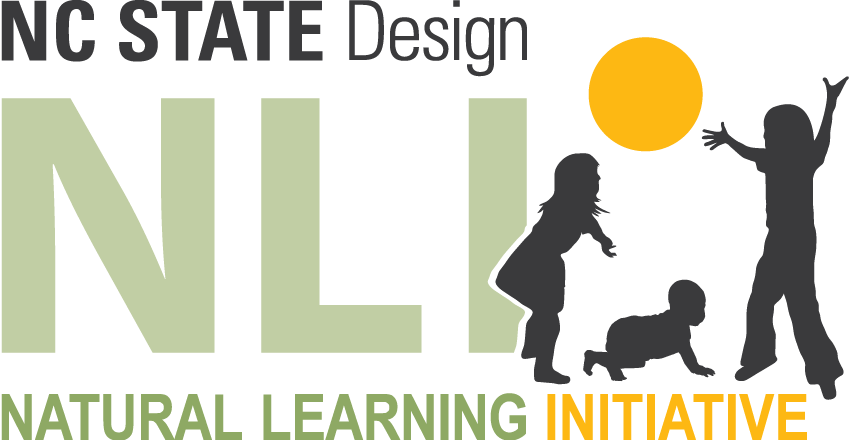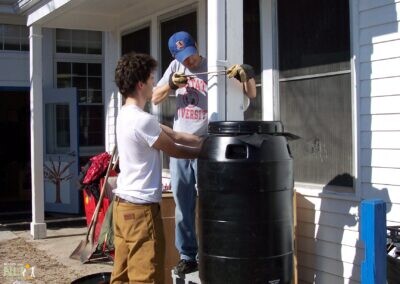Infosheets
25. Harvesting Water with Rain Barrels
A rain barrel is a container that captures and stores rainwater from roof downspouts. Barrels usually range from 50 to 80 gallons. Smaller rain barrels may be explicitly repurposed. All have a spigot for filling watering cans and sometimes a soaker hose connection. Installing rain barrels at childcare centers reduces water bills, slows storm-water run-off, and models responsible natural resource stewardship for children and adults.
STEPS
Identify downspouts suited for rain barrels and calculate the number needed. For a large roof area, consider interconnecting barrels at their upper level or a single, higher-capacity cistern—available in various sizes from agricultural suppliers and home improvement stores. Ensure selected downspouts are free-flowing and functioning properly.
Create a stable base for each rain barrel. Remove rocks, grass, and other vegetation from the desired location. Level the soil. Apply a 2-inch layer of leveling sand if necessary. Rain barrels provide a “hydraulic head” for irrigation and rapid flow to fill watering cans. Elevate barrels so watering cans fit under the spigot by supporting the barrel base on a double stack of cinder blocks on the leveled ground. Stack the second row rotated in the opposite direction. Turn the block openings inward, to prevent children from climbing (Figure 2).
Cut the downspout (Figure 2). With the barrel on top of stacked cinder blocks, mark the downspout connection point approximately 12 inches above the top of the barrel and cut to size with a hacksaw.
Attach downspout connectors. Adjust the downspout height above the barrel so low-flow events can drip into the barrel and high flow events will not gush over the barrel edge. Downspout connectors or “elbows” may need to be purchased, or can be repurposed from the downspout pieces cut during the previous step.
Connect an overflow hose. If an existing surface drainage system exists, connect a length of garden hose to the overflow spigot on the barrel (or end one of a series) and the other end to the existing system. If surface drains are absent, consider one of several possibilities. Connect the overflow hose to a dry stream bed (see InfoSheet 36: Dry Stream Beds) or with a sufficient hydraulic head, connect a soaker hose installed in a planting bed. As a last resort, overflow water should be directed via a hose away from the building to prevent standing water.
Attach support strap. Attach an eye hook to a secure, stable part of a solid post or wall (Figure 3). Wrap the strap around the barrel and attach it to the eye hook. This safety step prevents the rain barrel from tipping over.
Discuss with staff, parents, and children the benefits of collecting rainwater and provide them with a link or print copy of this InfoSheet to encourage installation at home. Consider holding a rain barrel workshop to engage community members in helping with installation and sharing knowledge (see Resource 1 below).
Materials & Tools:
- Rain barrel(s)
- 4 cinder blocks/barrel
- Downspout connector/barrel
- Overflow connector/barrel
- Support strap/barrel
- 1-2 eye hooks/barrel
- Hacksaw and blades
Resources
- NC State University Rainwater Harvester Model User Guide: https://content.ces.ncsu.edu/rainwater-harvesting-guidance-for-homeowners
- How to Teach Preschoolers About Water Conservation: https://homeguides.sfgate.com/teach-preschoolers-water-conservation-78769.html
- All the Water in the World, by George Ella Lyon & Katherine Tillotson. An inspiring poem about the importance of water for plants, animals, humans, and other living things. Includes facts about water conservation for the health of all life on earth.
Engage children. Children love watering and will go back and forth endlessly filling watering cans and delivering water to plants (Figure 4). Rain barrel water can be used for all plants except vegetables.
In periods of drought, use collected water more deliberately and discuss with children how life depends on water and the importance of not wasting it (see Resources 2 & 3 below). Discuss with children what messages could be painted on the barrel to help everyone understand what water does. Facilitate execution of the ideas (Figure 1).
HEALTH AND SAFETY
- Recycled rainwater is not suitable for consumption, water play, or watering vegetable gardens.
- Ensure that children wash their hands with potable water after handling recycled rainwater.




